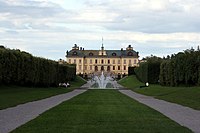
Ekerö Municipality is a municipality in the province of Uppland in Stockholm County in east central Sweden. The name derives from the name of the main island within the municipality whose name is Ekerön, and literally means "Oak Island". Its seat is located in the town of Ekerö.

The monarchy of Sweden is centred on the monarchical head of state of Sweden, by law a constitutional and hereditary monarchy with a parliamentary system. There have been kings in what now is the Kingdom of Sweden for more than a millennium. Originally an elective monarchy, it became a hereditary monarchy in the 16th century during the reign of Gustav Vasa, though virtually all monarchs before that belonged to a limited and small number of political families which are considered to be the royal dynasties of Sweden.

Stockholm Palace or the Royal Palace is the official residence and major royal palace of the Swedish monarch. Stockholm Palace is in Stadsholmen, in Gamla stan in the capital, Stockholm. It neighbours the Riksdag building. The offices of the King, the other members of the Swedish royal family, and the Royal Court of Sweden are here. The palace is used for representative purposes by the King whilst performing his duties as the head of state.

Louisa Ulrika of Prussia was Queen of Sweden from 1751 to 1771 as the wife of King Adolf Frederick. She was queen mother during the reign of King Gustav III.

Count Nicodemus Tessin the Younger was a Swedish Baroque architect, city planner, and administrator.

Sophia Magdalena of Denmark was Queen of Sweden from 1771 to 1792 as the wife of King Gustav III.

Hedwig Eleonora of Holstein-Gottorp was Queen of Sweden from 1654 until 1660 as the wife of King Charles X Gustav. She served as regent during the minority of her son, King Charles XI, from 1660 until 1672, and during the minority of her grandson, King Charles XII, in 1697. She also represented Charles XII during his absence in the Great Northern War from 1700 until the regency of her granddaughter Ulrika Eleonora in 1713. Hedwig Eleonora was described as a dominant personality, and was regarded as the de facto first lady of the royal court for 61 years, from 1654 until her death.

Strömsholm Palace, sometimes called Strömsholm Castle, is a Swedish royal palace. The baroque palace is built on the site of a fortress from the 1550s, located on an island in the Kolbäcksån river at the west end of Lake Mälaren. The palace has interiors from the 18th century and an important collection of Swedish paintings.

Ulriksdal Palace is a royal palace situated on the banks of the Edsviken in the Royal National City Park in Solna Municipality, 6 km north of Stockholm. It was originally called Jakobsdal for its owner Jacob De la Gardie, who had it built by architect Hans Jacob Kristler in 1638–1645 as a country retreat. He later passed on to his son, Magnus Gabriel De la Gardie, from whom it was purchased in 1669 by Queen Hedvig Eleonora of Sweden. The present design is mainly the work of architect Nicodemus Tessin the Elder and dates from the late 17th century.
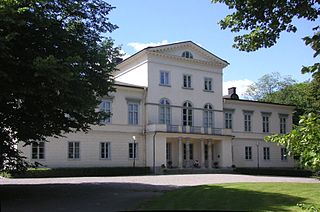
Haga Palace, formerly known as the Queen's Pavilion, is located in the Haga Park, Solna Municipality in Metropolitan Stockholm, Sweden. The palace, built between 1802 – 1805, was modelled after ballet-master Gallodiers Italian villa in Drottningholm by architect Carl Christoffer Gjörwell on appointment by King Gustaf IV Adolf for the royal children. It has been the home or summerhouse for several members of the Swedish royal family – most notably it was the birthplace of the present King – until 1966 when King Gustaf VI Adolf transferred its disposal to the government and it was turned into a guesthouse for distinguished foreign official visitors. In 2009, it was announced by Prime Minister Fredrik Reinfeldt that the rights of disposal to the palace would be transferred back to the royal court to be used by Victoria, Crown Princess of Sweden and her husband, Prince Daniel, Duke of Västergötland, as a wedding gift in 2010. They moved into Haga Palace after their wedding on 19 June that year.

Confidencen, or Ulriksdal Palace Theatre, is a theatre in the park of Ulriksdal Palace in Solna, in the Swedish capital Stockholm. Built in the 1750s and restored from the late 20th century, it is the oldest Rococo theatre in Sweden.

The Chinese Pavilion, located in the grounds of the Drottningholm Palace park, is a Chinese-inspired royal pavilion originally built between 1753 and 1769. The pavilion is currently one of Sweden's Royal Palaces and a UNESCO World Heritage Site.

Rosersberg Palace is one of the Royal Palaces of Sweden. Situated on the shores of Lake Mälaren, on the outskirts of Stockholm, it was built in the 1630s by the Oxenstierna family and became a royal palace in 1762, when the state gave it to Duke Karl, the younger brother of Gustav III of Sweden.

Karlberg Palace is a palace by the Karlberg Canal in Solna Municipality in Sweden, adjacent to Stockholm's Vasastaden district. The palace, built in 1630, today houses the Military Academy Karlberg.
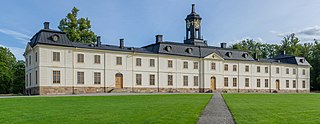
Svartsjö Palace is a Rococo palace situated in Svartsjö on the island of Färingsö in lake Mälaren. It lies just outside of Stockholm.

Ekolsund Castle is a manor house situated at Enköping Municipality in Uppsala County, Sweden. It is a former royal château, a well-preserved baroque building with 18th-century character.
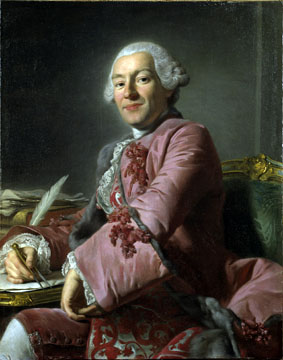
Carl Fredrik Adelcrantz was a Swedish architect and civil servant. Adelcrantz's style developed from a rococo influenced by Carl Hårleman, the leading architect in Sweden in the early years of his career, to a classical idiom influenced by the stylistic developments in France in the mid-to-late 18th century. As överintendent, he headed the royal and public building works from 1767 until his retirement in 1795.
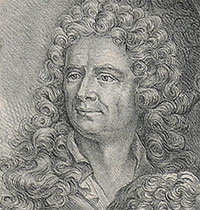
Burchard Precht was a Swedish-German furniture maker and sculptor. He is best known for his contributions to Stockholm Cathedral and Uppsala Cathedral; he designed the altarpiece for Uppsala in 1728. Precht and his workshop also created other church furnishings, including epitaphs, and a large amount of furniture, primarily gilded tables, guéridons and ornamental frames for mirrors and pictures.
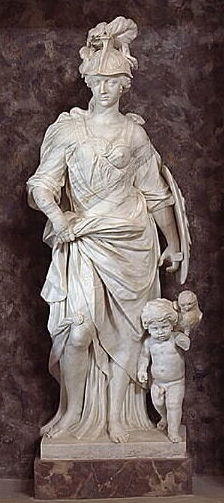
Nicolaes Millich or Nicholas Millich was a Flemish sculptor, architect and designer of armor and ephemeral objects. He worked for most of his career in Sweden. He was court sculptor to king Charles X Gustav of Sweden and later worked for the king's widow Hedwig Eleonora of Holstein-Gottorp. His main creation in Sweden was the execution of the sculptural programme of the staircase and hall of Drottningholm Palace, the private residence of the Swedish royal family. He also worked on various grave monuments and epitaphs of prominent Swedes.

L'Ordre de l'Harmonie, also called Solfjädersorden, was a Swedish royal dynastic order, founded by Queen Louisa Ulrika of Sweden in 1744. It was awarded to 22 people between 1744 and 1746.











